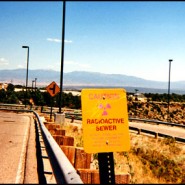Safe Storage of Transuranic Waste

Safe Containment
The container, called Transuranic Packaging Transporter Model 2, or TRUPACT-II, is:
- Eight feet in diameter and 10 feet high.
- Doubly-contained, non-vented, and constructed of stainless steel.
- Certified by the Nuclear Regulatory Commission and meets U.S. Department of Transportation safety requirements.
A series of stringent tests conducted on the container included:
- A drop from a height of 30 feet onto an unyielding surface.
- Exposure to jet fuel fire at a temperature of 1,475 degrees Fahrenheit for a minimum of 30 minutes.
- A drop onto a steel spike from 40 inches to test puncture resistance.
The tests showed that the container would hold its seal and prevent release of radioactivity to the atmosphere.
Safe Storage at WIPP
Why Salt?
Let’s look at storage at the WIPP facility in New Mexico, as an example.
Government officials and scientists chose the Waste Isolation Pilot Plant (WIPP) site through a selection process that started in the 1950s. At that time, the National Academy of Sciences conducted a nationwide search for geological formations stable enough to contain wastes for thousands of years. In 1955, after extensive study, salt deposits were recommended as a promising medium for the disposal of radioactive waste. Since then, bedded salt has been one of the leading candidates for the permanent disposal of radioactive waste.
Why is salt the material of choice for the planned disposal of some nuclear waste? Are there advantages to rock salt?
Salt offers the following advantages:
- Most deposits of salt are found in stable geological areas with very little earthquake activity, assuring the stability of a waste repository.
- Salt deposits demonstrate the absence of flowing fresh water that could move waste to the surface. Water, if it had been or were present, would have dissolved the salt beds.
- Salt is relatively easy to mine.
- Rock salt heals its own fractures because of its plastic quality. That is, salt formations will slowly and progressively move in to fill mined areas and safely seal radioactive waste from the environment.
Salt formations at the WIPP were deposited in thick beds during the evaporation of an ancient ocean, the Permian Sea. These geologic formations consist mainly of sodium chloride rock, the same substance that, in granular form, is in a salt shaker on the kitchen table. The primary salt formation containing the WIPP mine is about 2,000 feet thick, beginning 850 feet below the surface.
Formed about 225 million years ago during the Permian Age, large expanses of uninterrupted salt beds provide a repository free from the disturbances of large earthquakes. That proven stability over such a long time span offers the predictability that the salt will remain stable for a comparatively short quarter million years. That’s about how long the WIPP-bound waste will take to lose most of its harmful radioactivity and no longer be a threat to the environment.
At the depth of the WIPP repository, the salt will slowly encapsulate the buried waste in the stable rock. Relatively small amounts of brine, salt-saturated water, were trapped in the formations millions of years ago. Moisture and salt molecules in the brine will help the recrystallization process to naturally encapsulate the waste in the salt. Meanwhile, salt rock also provides shielding from radioactivity similar to that of concrete.
In a future post, I will review the Yucca Mountain facility and the reasons it was selected as a long-term waste storage facility. Because of political pressure, and public misconceptions due to unfair media portrayals and the dissemination of incorrect information from some environmental groups, it may be difficult to ever find a permanent waste storage facility in the US. I will also cover how the nuclear industry is dealing with a failure of the political system to approve new storage facilities, and how even this is tremendously safe!

 Dr. John D. Johnson has a background in nuclear, experimental & accelerator physics. He worked for Los Alamos National Laboratory in the 1990s and founded Docent Institute to raise awareness about the ethical use of advanced technology.
Dr. John D. Johnson has a background in nuclear, experimental & accelerator physics. He worked for Los Alamos National Laboratory in the 1990s and founded Docent Institute to raise awareness about the ethical use of advanced technology.